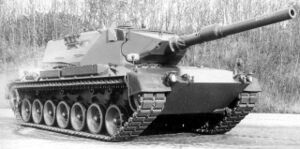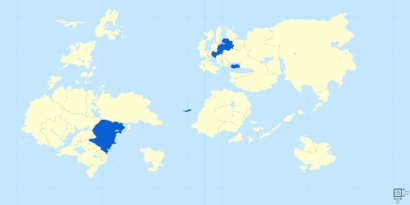Jaguar III
This article is incomplete because it is pending further input from participants, or it is a work-in-progress by one author. Please comment on this article's talk page to share your input, comments and questions. Note: To contribute to this article, you may need to seek help from the author(s) of this page. |
| Jaguar III | |
|---|---|
 Jaguar III Ausf. A5 of the Kaiserliche Heer | |
| Type | Main battle tank |
| Place of origin | |
| Service history | |
| In service | 1983-Present |
| Used by | See Operators |
| Production history | |
| Designer | Kempenhaus-Pollmächer |
| Designed | 1976-1980 |
| Manufacturer | Kempenhaus-Pollmächer Kaiserlicher Maschinenfabrik Weilheim |
| Unit cost | 2A6: WIP |
| Produced | 1979-Present |
| No. built | ~3,250 (including foreign exports) |
| Variants | See Variants |
| Specifications | |
| Weight | Ausf A6: 62.3 t |
| Length | Ausf A6: 9.97 m (gun forward) |
| Width | Ausf A6: 3.75 m |
| Height | Ausf A6: 3.0 m |
| Crew | 4 |
| Armour | Ausf A6: 3rd generation composite; including high-hardness steel, tungsten and plastic filler with ceramic component. |
Main armament | 1× Stebertstahl KwK 78 L/44 smoothbore gun (42 rounds) |
Secondary armament | 2× 7.62×51mm Kaiserlicher Waffenfabrik MG65 n.A. (4,750 rounds) |
| Engine | Maibach MiB-45 liquid-cooled V12 twin-turbo diesel engine 1,500 PS (1,479 hp 1,103 kW at 2,600 rpm |
| Power/weight | 24.1 PS/t |
| Transmission | Fitkau HSWL 567 |
| Suspension | Torsion bar suspension |
| Fuel capacity | 1,200 km |
Operational range | 550 km (internal fuel) |
| Speed | 68 km/h |
The Jaguar III, officially Panzerkampfwagen XXII (Sd.Kfz. 4098), is a main battle tank developed by Kempenhaus-Pollmächer from 1976-1980 as a successor to the Jaguar II MBT that was seen as not sufficient for the modern battlefield. The vehicle was designed as a third-generation main battle tank with capabilities of being upgraded well into the future, and adaptable to all environments. It is armed with a 120 mm smoothbore cannon, and is powered by a V-12 twin-turbo diesel engine. As of 2019, a wide number of variants have been developed both by the Englean Kaiserreich and other operators for a variety of operations.
Early iterations of the tank continued the design of the ill-fated Jaguar II, with those up to Ausf. A4 retaining the vertical faced composite turret armour and succeeding variants (Ausf. A5-A8) sporting angled turret appliqué armour. All models feature digital fire control systems with laser rangefinders, a fully stabilised main gun and coaxial machine gun, and advanced night vision and sighting equipment (first vehicles used a low-light level TV system or LLLTV; thermal imaging was introduced later on). The Jaguar III is set to continue in service with the Englean Kaiserliche Heer until being fully replaced by the Jaguar IV in 2030.
History
Development
As of 1970, the Jaguar I had been in service with the Kaiserliche Heer since 1946 and was becoming dated. Although many upgrades had been developed, including a full revamped armour package and addition of a 120mm gun, the vehicle still showed its age in relation to vehicles being produced within the world. In response to this, the Oberste Heeresleitung ordered the development of a replacement MBT that would combine speed with the prototype 120mm smoothbore cannon that was also being developed at the time. Vehicle manufacturer Vollhards-Wiesgätter won the design competition with their Neu-Kampfpanzer, which implemented a vastly different chassis and turret design from the previous Jaguar I variant, the Jaguar I Ausf. L.
The design was then ordered to begin prototype production as Projekt 198 in 1972, with the first two prototypes being finished by the end of the year. These prototypes sported longer chassis, as well as a slim turret that housed the 120mm main gun intended for the MBT. However. many of the features of the vehicles did not operate as intended and eventually led to the cancellation of the project in 1974. This resulted in the Jaguar I continuing to be the primary MBT of the Kaiserliche Heer until 1976, when the OHL ordered the development of another MBT under the codename vergoldeter Jaguar.

Design
Variants
Technical Data
Operators
Current operators
 Englean Kaiserreich: 650 Jaguar III (Ausf. A4-A8) operational
Englean Kaiserreich: 650 Jaguar III (Ausf. A4-A8) operational : 67 Jaguar III (Ausf. A1-A4) operational
: 67 Jaguar III (Ausf. A1-A4) operational- Eastern North Islands: 4 Jaguar III Ausf. A5 (export variant) operational
